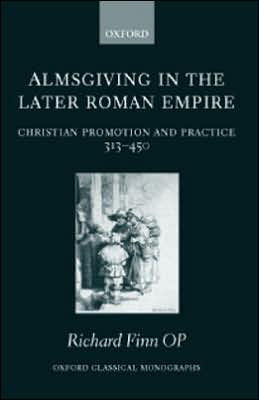Posted October 1, 2006
Book: Almsgiving in the Later Roman Empire: Christian Promotion and Practice 313-450
Author: Richard Finn, OP
Oxford University Press. New York. 2006. Pp. 302
An Excerpt from the Jacket:
Richard Finn OP sets out and examines the distinctive forms taken by almsgiving in the churches of the later empire, each of which was significant for the identity and status of the bishops, ascetics, and lay people who understood them. He shows that these practices differed in kind or context from the almsgiving practiced by pagans. Episcopal almsgiving, which was variously funded and benefitted primarily a group of registered widows and orphans, as well as a small number of the Christian destitute, was crucial in the construction of the bishopís standing, yet it was also a co-operative task in which honor was shared and which exposed the bishop to criticism and rivalry. Almsgiving by monks is set in the context of radical self-dispossession which attracted further alms for distribution to the destitute; however, monastic almsgiving proved controversial because of the temptations it brought and because of the potential for competition with bishops. Finn describes in detail how lay people, who gave alms both to the church and directly to the destitute, characteristically donated as penitents and pilgrims, and were encouraged to give at set times and in particular places. He examines how these practices gained meaning from the discourse sustaining them. The promotion of almsgiving took many forms, of which preaching was the most important. Such promotion involved a redefinition of the poor and the incorporation of almsgiving within the virtues of generosity and justice. In this way, almsgiving became a benefaction, a source of honor and leadership. This distinctive pattern of thought and conduct came into conflict with the older classical patterns, generating controversy, for example, over the conduct of bishops and consecrated virgins. The co-inherence of co-operation and competition in Christian almsgiving, together with the continued existence of traditional euergetism, meant, however, that Christian alms did not turn bishops into the supreme patrons of their cities.
An Excerpt from the Book:
Pontius suggests the way in which preachers encouraged almsgiving as a means of winning Godís blessing, their appeal to self-interest, and the crucial description of almsgiving as an expression of generosity, but not the degree to which the different voices of Christians discourse in the fourth and fifth centuries would redescribe the poor as brethern, friends, and fellow servants, whose prayers now constituted a valuable return from alms received. Almsgiving was incorporated into a moral theology of the virtues, in particular as an expression of philanthropia, liberalitas, humanitas, and justitia. These virtues brought to almsgiving a new honor and status for practitioners.
Table of Contents:
Introduction
Episcopal almsgiving
Almsgiving by monks and lay Christians
The promotion of Christian almsgiving
The meaning of Christian almsgiving
Christian and classical
Concluding remarks.
|
|
|

